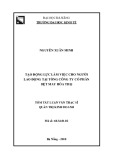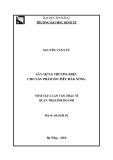
Hindawi Publishing Corporation
Advances in Difference Equations
Volume 2011, Article ID 378686, 9pages
doi:10.1155/2011/378686
Research Article
On the Existence of Solutions for
Dynamic Boundary Value Problems under
Barrier Strips Condition
Hua Luo1and Yulian An2
1School of Mathematics and Quantitative Economics, Dongbei University of Finance and Economics,
Dalian 116025, China
2Department of Mathematics, Shanghai Institute of Technology, Shanghai 200235, China
Correspondence should be addressed to Hua Luo, luohuanwnu@gmail.com
Received 24 November 2010; Accepted 20 January 2011
Academic Editor: Jin Liang
Copyright q2011 H. Luo and Y. An. This is an open access article distributed under the Creative
Commons Attribution License, which permits unrestricted use, distribution, and reproduction in
any medium, provided the original work is properly cited.
By defining a new terminology, scatter degree, as the supremum of graininess functional value,
this paper studies the existence of solutions for a nonlinear two-point dynamic boundary value
problem on time scales. We do not need any growth restrictions on nonlinear term of dynamic
equation besides a barrier strips condition. The main tool in this paper is the induction principle
on time scales.
1. Introduction
Calculus on time scales, which unify continuous and discrete analysis, is now still an active
area of research. We refer the reader to 1–5and the references therein for introduction
on this theory. In recent years, there has been much attention focused on the existence and
multiplicity of solutions or positive solutions for dynamic boundary value problems on time
scales. See 6–17for some of them. Under various growth restrictions on nonlinear term of
dynamic equation, many authors have obtained many excellent results for the above problem
by using Topological degree theory, fixed-point theorems on cone, bifurcation theory, and so
on.
In 2004, Ma and Luo 18firstly obtained the existence of solutions for the dynamic
boundary value problems on time scales
xΔΔtft, xt,x
Δt,t∈0,1
Ì
,
x00,x
Δσ1 01.1

2AdvancesinDifference Equations
under a barrier strips condition. A barrier strip Pis defined as follows. There are pairs two
or fourof suitable constants such that nonlinear term ft, u, pdoes not change its sign on
sets of the form 0,1
Ì
×−L, L×P,whereLis a nonnegative constant, and Pis a closed
interval bounded by some pairs of constants, mentioned above.
The idea in 18was from Kelevedjiev 19, in which discussions were for boundary
value problems of ordinary differential equation. This paper studies the existence of solutions
for the nonlinear two-point dynamic boundary value problem on time scales
xΔΔtft, xσt,x
Δt,t∈a, ρ2b
Ì
,
xΔa0,x
b0,1.2
where
is a bounded time scale with ainf
,bsup
,anda<ρ
2b.Weobtainthe
existence of at least one solution to problem 1.2without any growth restrictions on fbut
an existence assumption of barrier strips. Our proof is based upon the well-known Leray-
Schauder principle and the induction principle on time scales.
The time scale-related notations adopted in this paper can be found, if not explained
specifically, in almost all literature related to time scales. Here, in order to make this paper
read easily, we recall some necessary definitions here.
A time scale
is a nonempty closed subset of
; assume that
has the topology that it
inherits from the standard topology on
. Define the forward and backward jump operators
σ, ρ :
→
by
σtinf{τ>t|τ∈
},ρ
tsup{τ<t|τ∈
}.1.3
In this definition we put inf ∅sup
,sup ∅inf
.Setσ2tσσt,ρ
2tρρt.The
sets
kand
kwhich are derived from the time scale
are as follows:
k:t∈
:tis not maximal or ρtt,
k:{t∈
:tis not minimal or σtt}.
1.4
Denote interval Ion
by I
Ì
I∩
.
Definition 1.1. If f:
→
is a function and t∈
k, then the delta derivative of fat the point
tis defined to be the number fΔtprovided it existswith the property that, for each ε>0,
there is a neighborhood Uof tsuch that
fσt −fs−fΔtσt−s
ε|σt−s|1.5
for all s∈U. The function fis called Δ-differentiable on
kif fΔtexists for all t∈
k.
Definition 1.2. If FΔfholds on
k, then we define the Cauchy Δ-integral by
t
s
fτΔτFt−Fs,s,t∈
k.1.6

Advances in Difference Equations 3
Lemma 1.3 see 2, Theorem 1.16 SUF.If fis Δ-differentiable at t∈
k,then
fσt ftσt−tfΔt.1.7
Lemma 1.4 see 18, Lemma 3.2.Suppose that f:a, b
Ì
→
is Δ-differentiable on a, bk
Ì
,
then
ifis nondecreasing on a, b
Ì
if and only if fΔt≥0,t∈a, bk
Ì
,
iifis nonincreasing on a, b
Ì
if and only if fΔt≤0,t∈a, bk
Ì
.
Lemma 1.5 see 4,Theorem1.4.Let
be a time scale with τ∈
. Then the induction principle
holds.
Assume that, for a family of statements At,t∈τ, ∞
Ì
, the following conditions are
satisfied.
1Aτholds true.
2For each t∈τ, ∞
Ì
with σt>t,onehasAt⇒Aσt.
3For each t∈τ, ∞
Ì
with σtt, there is a neighborhood Uof tsuch that At⇒As
for all s∈U, s > t.
4For each t∈τ, ∞
Ì
with ρtt,onehasAsfor all s∈τ, t
Ì
⇒At.
Then Atis true for all t∈τ, ∞
Ì
.
Remark 1.6. For t∈−∞,τ
Ì
,wereplaceσtwith ρtand ρtwith σt, substitute <for >,
then the dual version of the above induction principle is also true.
By C2a, b, we mean the Banach space of second-order continuous Δ-differentiable
functions x:a, b
Ì
→
equipped with the norm
xmax|x|0,
xΔ
0,
xΔΔ
0,1.8
where |x|0maxt∈a,b
Ì
|xt|,|xΔ|0maxt∈a,ρb
Ì
|xΔt|,|xΔΔ|0maxt∈a,ρ2b
Ì
|xΔΔt|.
According to the well-known Leray-Schauder degree theory, we can get the following
theorem.
Lemma 1.7. Suppose that fis continuous, and there is a constant C>0, independent of λ∈0,1,
such that x<Cfor each solution xtto the boundary value problem
xΔΔtλft, xσt,x
Δt,t∈a, ρ2b
Ì
,
xΔa0,x
b0.1.9
Then the boundary value problem 1.2has at least one solution in C2a, b.
Proof. Theproofisthesameas18,Theorem4.1.

4AdvancesinDifference Equations
2. Existence Theorem
To state our main result, we introduce the definition of scatter degree.
Definition 2.1. For a time scale
, define the right direction scatter degree RSDand the left
direction scatter degree LSDon
by
r
supσt−t:t∈
k,
l
supt−ρt:t∈
k,
2.1
respectively. If r
l
,thenwecallr
or l
the scatter degree on
.
Remark 2.2. 1If
,thenr
l
0. If
h
:{hk :k∈
,h>0},then
r
l
h.If
q
Æ
:{qk:k∈
}and q>1, then r
l
∞.2If
is
bounded, then both r
and l
are finite numbers.
Theorem 2.3. Let f:a, ρb
Ì
×
2→
be continuous. Suppose that there are constants Li,i
1,2,3,4,withL2>L
1≥0,L3<L
4≤0satisfying
H1L2>L
1Mr
,L
3<L
4−Mr
,
H2ft, u, p≤0for t, u, p∈a, ρb
Ì
×−L2b−a,−L3b−a ×L1,L
2,ft, u, p≥0
for t, u, p∈a, ρb
Ì
×−L2b−a,−L3b−a ×L3,L
4,
where
Msup
ft, u, p
:t, u, p∈a, ρb
Ì
×−L2b−a,−L3b−a ×L3,L
2.2.2
Then problem 1.2has at least one solution in C2a, b.
Remark 2.4. Theorem 2.3 extends 19,Theorem3.2even in the special case
.Moreover,
our method to prove Theorem 2.3 is different from that of 19.
Remark 2.5. We can find some elementary functions which satisfy the conditions in
Theorem 2.3. Consider the dynamic boundary value problem
xΔΔt−xΔt3ht, xσt,x
Δt,t∈a, ρ2b
Ì
,
xΔa0,x
b0,2.3
where ht, u, p:a, ρb
Ì
×
2→
is bounded everywhere and continuous.
Suppose that ft, u, p−p3ht, u, p,thenfort∈a, ρb
Ì
ft, u, p−→ − ∞ ,if p−→ ∞,
ft, u, p−→ ∞,if p−→ − ∞ .2.4
It implies that there exist constants Li,i1,2,3,4, satisfying H1and H2in Theorem 2.3.
Thus, problem 2.3has at least one solution in C2a, b.

Advances in Difference Equations 5
Proof of Theorem 2.3.Define Φ:
→
as follows:
Φu⎧
⎪
⎪
⎪
⎨
⎪
⎪
⎪
⎩
−L2b−a,u≤−L2b−a,
u, −L2b−a<u<−L3b−a,
−L3b−a,u≥−L3b−a.
2.5
For all λ∈0,1, suppose that xtis an arbitrary solution of problem
xΔΔtλft, Φxσt,x
Δt,t∈a, ρ2b
Ì
,
xΔa0,x
b0.2.6
We firstly prove that there exists C>0, independent of λand x,suchthatx<C.
We show at first that
L3<x
Δt<L
2,t∈a, ρb
Ì
.2.7
Let At:L3<x
Δt<L
2,t∈a, ρb
Ì
. We employ the induction principle on time
scales Lemma 1.5to show that Atholds step by step.
1From the boundary condition xΔa0 and the assumption of L3<0<L
2,Aa
holds.
2For each t∈a, ρb
Ì
with σt>t, suppose that Atholds, that is, L3<x
Δt<
L2.Notethat−L2b−a≤Φxσt ≤−L3b−a; we divide this discussion into
three cases to prove that Aσt holds.
Case 1. If L4<x
Δt<L
1,thenfromLemma 1.3,Definition 2.1,andH1there is
xΔσt xΔtxΔΔtσt−t
<L
1Mr
<L
2.
2.8
Similarly, xΔσt >L
4−Mr
>L
3.
Case 2. If L1≤xΔt<L
2, then similar to Case 1we have
xΔσt xΔtxΔΔtσt−t
>L
4−Mr
>L
3.
2.9









![Hình ảnh học bệnh não mạch máu nhỏ: Báo cáo [Năm]](https://cdn.tailieu.vn/images/document/thumbnail/2024/20240705/sanhobien01/135x160/1985290001.jpg)
















